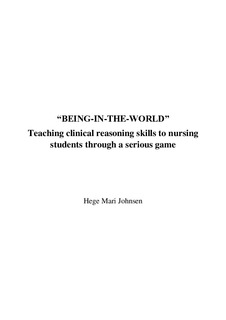| dc.description.abstract | Background: Nursing education faces the challenge to educate registered nurses (RNs)
with a high level of clinical reasoning skills and evidence-based knowledge, who are
able to provide safe and effective care to patients. Nursing educators are also
challenged to develop innovative and effective programs that align with current
changes in health care. Serious games (SGs) are computer-based simulations that may
provide nursing students with an opportunity to practice their clinical reasoning and
decision-making skills in realistic situations from the “real world” of clinical practice.
Purpose: The overall purpose of this project was to study recently graduated RNs’
clinical reasoning in clinical practice settings, and to use this knowledge to design,
develop and evaluate an SG prototype for teaching clinical reasoning and decisionmaking
skills to nursing students. Showing the SG’s educational value and user
acceptance among nursing students could justify the development and application of
more SGs in nursing education.
Designs, methods and samples: In Study I, an explorative qualitative think-aloud (TA)
design with protocol analysis was used to describe the cognitive processes and
thinking strategies used by recently graduated RNs while providing care for patients in
home healthcare clinical practice. A purposive sample of eight RNs participated in
three TA interviews each, for a total of twenty-four home healthcare visits.
Additionally, eight follow-up interviews with the RNs were conducted. In Study II, a
video-based SG prototype was developed for teaching clinical reasoning and decisionmaking
skills to nursing students who care for patients with chronic obstructive
pulmonary disease (COPD). The SG was developed based on the results from Study I,
theory and research related to SG design, experiential learning theory and decisionmaking
theory. A purposive sample of six participants evaluated the first scenario of
the SG prototype in a usability laboratory. The first SG scenario was from a home
healthcare setting. Cognitive walkthrough evaluations, a questionnaire and individual
interviews were used. In Study III, a pilot study was conducted of the final SG with a
convenience sample of 249 second-year nursing students. The final SG prototype
included two scenarios from a home healthcare setting and two scenarios from a
hospital setting. The pilot study involved the implementation of the SG prototype as
part of two simulation courses in the Bachelor of Nursing program: one for students
attending home healthcare clinical placements and one for students attending clinical
placements in medical-surgical wards in hospitals. A paper-based survey was then
used to assess the nursing students’ perceptions of the SG’s educational value in terms
of the SG’s degree of realism/authenticity (face validity), alignment of content and
tasks with curricula (content validity), and the SG’s ability to meet the learning
objectives (construct validity). In addition, the survey assessed perception of usability,
individual factors, and preferences regarding future use. A total of 120 participants
completed the survey, representing 48% of the nursing students in the two simulation
courses.
Results: Study I showed that RNs with one year of clinical practice used both simple
and complex cognitive processes and utilized metacognitive skills and ethical
reasoning. They also demonstrated the use of inductive and deductive reasoning.
However, the clinical reasoning of the RNs was highly influenced by domain-specific
knowledge and the context. In addition, their reasoning was more reactive than
proactive. Furthermore, knowing patients well could have both positive and negative
effects on clinical reasoning. The SG prototype developed in Study II was perceived as
having a content that was realistic and clinically relevant, and as having an adequate
level of complexity for the intended users. Despite some perceived usability issues,
most of the six participants agreed that the SG was useful, usable, and satisfying.
Necessary improvements were made and the remaining three SG scenarios, one from a
home healthcare setting and two from a hospital setting, were completed. Pilot testing
of the final SG prototype in Study III, showed that most students from both the
medical-surgical and home healthcare simulation courses perceived the SG as realistic,
educationally valuable and easy to use. No significant differences were found in
perception of realism or educational value between nursing students with or without
previous work experience in healthcare. However, significantly more students in the
home healthcare simulation course indicated that the SG tested their clinical reasoning
and decision-making skills. Students from both simulation courses agreed that more
video-based SGs should be developed and used in nursing education, especially in care
for patients with chronic diseases.
Conclusion: The results support the idea that experiential learning through video-based
SGs may aid students’ clinical reasoning, for example through heightening nursing
students’ awareness in promoting systematic assessment of patients, improving
recognition of patient deterioration and choosing appropriate interventions in specific
situations. The positive attitudes towards the SG and the call for more and similar SGs
within other areas of nursing education strongly support further development of this
kind of technology-enhanced learning in nursing education. | nb_NO |
